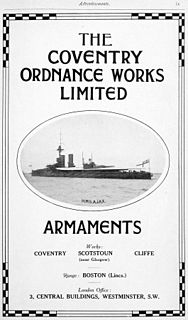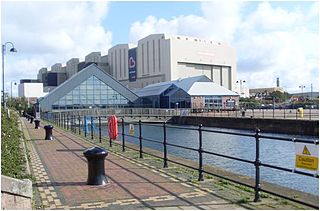Vickers was a famous name in British engineering that existed through many companies from 1828 until 1999.

Harland & Wolff is a shipyard, specialising in ship repair, conversion, and offshore construction, located in Belfast, Northern Ireland. Harland & Wolff is famous for having built the majority of the ocean liners for the White Star Line. Well-known ships built by Harland & Wolff include the Olympic-class trio: RMS Titanic, RMS Olympic and HMHS Britannic, the Royal Navy's HMS Belfast, Royal Mail Line's Andes, Shaw Savill's Southern Cross, Union-Castle's RMS Pendennis Castle, and P&O's Canberra. Harland and Wolff's official history, Shipbuilders to the World, was published in 1986.
Vickers-Armstrongs Limited was a British engineering conglomerate formed by the merger of the assets of Vickers Limited and Sir W G Armstrong Whitworth & Company in 1927. The majority of the company was nationalised in the 1960s and 1970s, with the remainder being divested as Vickers plc in 1977.

Vickers Shipbuilding and Engineering, Ltd (VSEL) was a shipbuilding company based at Barrow-in-Furness, Cumbria in northwest England that built warships, civilian ships, submarines and armaments. The company was historically the Naval Construction Works of Vickers Armstrongs and has a heritage of building large naval warships and armaments. Through a complicated history the company's shipbuilding division is now BAE Systems Submarine Solutions and the armaments division is now part of BAE Systems Land & Armaments.

Barrow Island is an area and electoral ward of Barrow-in-Furness, Cumbria, England. Originally separate from the British mainland, land reclamation in the 1860s saw the northern fringes of the island connect to Central Barrow. Barrow Island is also bound to the south and east by the town's dock system and to the west by Walney Channel. The Ward population taken at the 2011 census was 2,616.

Darlington railway works, was established in 1863 by the Stockton and Darlington Railway in the town of Darlington in the north east of England. The main part of the works, the North Road Shops was located on the northeast side of the Stockton and Darlington Railway

The Cockatoo Island Dockyard was a major dockyard in Sydney, Australia, based on Cockatoo Island. The dockyard was established in 1857 to maintain Royal Navy warships. It later built and repaired military and battle ships, and played a key role in sustaining the Royal Australian Navy. The dockyard was closed in 1991, and its remnants are heritage listed as the Cockatoo Island Industrial Conservation Area.

Samson and Goliath are the twin shipbuilding gantry cranes situated at Queen's Island, Belfast, Northern Ireland. The cranes, which were named after the Biblical figures Samson and Goliath, dominate the Belfast skyline and are landmark structures of the city. Comparative newcomers to the city, the cranes rapidly came to symbolise Belfast in a way that no building or monument had hitherto done.

BAE Systems Submarines, is a wholly owned subsidiary of BAE Systems, based in Barrow-in-Furness, Cumbria, England, and is responsible for the development and production of submarines.
Vickers Limited was a British engineering conglomerate. The business began in Sheffield in 1828 as a steel foundry and became known for its church bells, going on to make shafts and propellors for ships, armour plate and then artillery. Entire large ships, cars, tanks and torpedoes followed. Airships and aircraft were added, and Vickers jet airliners were to remain in production until 1965.

Coventry Ordnance Works was a British manufacturer of heavy guns particularly naval artillery jointly owned by Cammell Laird & Co of Sheffield and Birkenhead, Fairfield Shipbuilding and Engineering Company of Govan, Glasgow and John Brown & Company of Clydebank and Sheffield. Its core operations were from a 60-acre site in Stoney Stanton Road in the English city of Coventry, Warwickshire.

The Dock Museum is situated in Barrow-in-Furness, Cumbria, England. Most of its exhibits concern the history of the town, focusing on the shipbuilding industry at VSEL, the steelworks industry — of which Barrow once had the world's largest, the Furness Railway and the World War II bombings of the town. There has been a museum in Barrow since 1907 and in its current location since 1994, when 50,000 people visited it in its first year, visitor numbers peaked at 120,000 in 2001. The museum has free entry and remains under public ownership.
HMS L56 was a late-model L-class submarine built for the Royal Navy during the First World War. The boat was not completed before the end of the war and was sold for scrap in 1938.
HMS L71 was a late-model L-class submarine built for the Royal Navy during the First World War. The boat was not completed before the end of the war and was sold for scrap in 1938.

Devonshire Dock Hall is a large indoor shipbuilding and assembly complex that forms part of the BAE Systems shipyard in the Barrow Island area of Barrow-in-Furness, Cumbria, England.

The Joshua Hendy Iron Works was an American engineering company that existed from the 1850s to the late 1940s. It was at one time a world leader in mining technology and its equipment was used in the construction of the Panama Canal, amongst other major projects. The company went on to serve many different markets during the course of its existence, but is perhaps best remembered today for its contribution to the American shipbuilding industry during World War II.

The Port of Barrow refers to the enclosed dock system within the town of Barrow-in-Furness, England. Morecambe Bay is to the east of the port and the Irish Sea surrounds it to the south and west. The port is currently owned and operated by Associated British Ports Holdings, but some land is shared with BAE Systems Submarine Solutions. Currently consisting of four large docks, the Port of Barrow is one of North West England's most important ports. The docks are as follows: Buccleuch Dock, Cavendish Dock, Devonshire Dock and Ramsden Dock. The port of Barrow is the only deep water port between the Mersey and the Clyde.

The Barrow Hematite Steel Company Limited was a major iron and steel producer based in Barrow-in-Furness, Lancashire, England, between 1859 and 1963. At the turn of the 20th-century and the Technological Revolution it operated the largest steel mill in the world.

The Barrow Jute Works was a jute and flax mill located in Barrow-in-Furness, Lancashire, England during the late 19th and early 20th centuries. The mill was built for the Barrow and Calcutta Jute Company which was founded by James Ramsden in 1870 in an attempt to diversify Barrow's economy which was heavily focused on iron and steel production. The Jute Works itself was designed by architects Paley and Austin and occupied over 12-acres with a 580 feet (177 m) facade on Hindpool Road and 360 feet (110 m) along Abbey Road. The mill was served by its own railway station on a branch of the Furness Railway which connected it to the town's docks, steelworks and cornmill.

Ramsden Square is a square located at the intersection of Abbey Road and Duke Street in Barrow-in-Furness, Cumbria, England. It marks the boundary of the Central and Hindpool wards and now acts as a major roundabout. Ramsden Square was first laid out in the 1840s to act as a focal point of Sir James Ramsden's master plan for the new town of Barrow, separating its burgeoning industries and commercial core. The centerpiece of the square is a statue of Ramsden himself while it is framed by a number of historic buildings including Barrow Central Library, the National Westminster Bank Building and formerly the Barrow Jute Works.
















